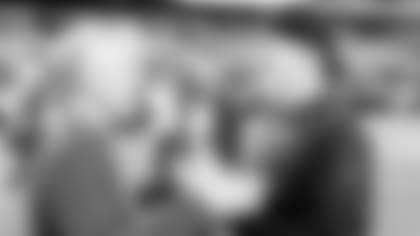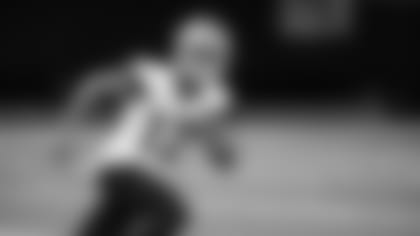The most productive restructuring plan the Cowboys launched in recent memory was started partly by chance. The best ones sometimes are.
When they spent the ninth pick of the 2011 NFL Draft on Tyron Smith, Dallas had not used a first-round pick on an offensive lineman in 20 years. They knew they needed line help. They even knew they had to rebuild the line. They knew Smith was a rare, young talent who wouldn't come around often.
They did not know they would be spending first-round picks on Travis Frederick and Zack Martin when they did. Events of each draft present themselves uniquely. If the Steelers hadn't taken Ryan Shazier with the 15th selection in 2014, the Cowboys probably would have at 16. Instead, they got Martin, arguably the best guard in football.
That made the first-round draft rebuild of the Cowboys' line complete, to the extent first-round picks would be spent on it. But in 2011, that couldn't have been the design. You never know what the draft will present. You just need to have a plan to react.
We may be seeing that now play itself out in the Cowboys' secondary.
It did not sneak up suddenly last February on team executives that Brandon Carr, Barry Church, Morris Claiborne and J.J. Wilcox had expiring contracts. They knew it was coming. This is the part of running an NFL franchise that is not so Twitter-and-talk-show friendly. You have to manage an entire team's cap, and not one year at a time. Sometimes you make the right decisions. Sometimes you miss. It's never perfect.
Spending big on Carr in 2012 free agency seemed like the right move. And he was as reliable as sunrise. Solid member of the community, team leader, never missed a game. Didn't produce zillions of interceptions. In fact, just one the last three years. That's part of the reason the Cowboys didn't re-sign him, fair or unfair. But you could see the plan. Sign Carr, trade up to draft Claiborne the same year. The plan was to be set at corner, with those two and then five-year veteran Orlando Scandrick.
But after getting three interceptions in each of his first two seasons, Carr didn't find the ball, and Claiborne had numerous injuries and couldn't stay on the field. And Church, a reliable leader and team captain, was a seven-year veteran.
The Cowboys looked at their secondary, looked at production and the salary cap ahead and their recent experience. They decided they would make competitive bids but understood those players might find more money elsewhere. The plan was to go to school on the offensive line and build through the draft, and be prepared to play the young players. Some coaches resist that, but it's the way of the 21st century NFL world.
Do the Cowboys miss those players? Sure. They were good players. They probably miss Church most, and they might have liked their safety play to have been steadier all year. But examine the plan, what it's been through and where it is.
[embeddedad0]
Draft day brought Chidobe Awuzie in the second round, Jourdan Lewis in the third and Xavier Woods in the sixth. Lewis was thought to have fallen because of a long-since resolved off-the-field issue. Woods was a player with a higher grade who was worth a trade up. Once they got those players at The Star for OTAs and the offseason program, the staff saw nothing to dissuade from its original opinions.
A quick word here about the offseason. The way the Collective Bargaining Agreement controls practices, coaches must be adept at evaluating what they have going into training camp. Workouts in shorts, of which media sees only about a third, and meetings to which only the team is privy, provide the basis of those evaluations. Accept it or not, they know stuff we don't. For the most part, rosters are picked before training camp starts.
Then things happen. Rookies-to-be don't do offseason football training. They're preparing for the Scouting Combine and Pro Days. They're workout-ready, not football-ready. And if you get particularly unlucky, you get what the Cowboys got in July. All three of those rookies, and others, suffered hamstring injuries in camp.
Lewis', it turned out, was initially the worst. Happened around the second day in Oxnard, Calif., and was diagnosed (although not announced) as a four-to-five week injury. Awuzie has spent most of the season getting not just healthy but game ready. Woods had a great showing in the Hall of Fame game and then went on the shelf.
Of the Cowboys' first 13 games, Awuzie was inactive for six. Lewis and Woods have been available for all but one (Lewis in the opener), but all of those snaps they missed in training camp and the preseason games cannot be replaced. None of them was the player he might have been even at the outset had those things not happened. But they did, and the Cowboys' defensive struggles have been part of the backwash. You don't subtract the four players they didn't re-sign AND not have those three drafted replacements and not show it.
But the last two weeks have provided a glimpse of what the plan might have been and might yet be. Anthony Brown (who started games two through 11) has shown himself to still be a useful, competitive player. But against the Giants, with Scandrick injured, Lewis and Awuzie were the starting corners, and they might well be in Oakland. Woods deploys early as a nickel corner, something he never did at Louisiana Tech but has demonstrated he can handle. Toss in Brown and a suddenly emergent second-year safety Kavon Frazier, and you begin to see a future, a plan. Even if it's a plan that presented itself in stages.
None of this means the Cowboys won't draft another cornerback next spring. Obviously, you never have enough. Doesn't mean they're still not looking for the next Darren Woodson or Cliff Harris or Charlie Waters. It means that what we've seen all season was not quite the plan. What we're seeing now is closer to the plan. Sometimes the plan doesn't work.
And sometimes it just takes longer to present itself.














